WordPressサイトを新しいドメインに移行することは、慎重な計画を必要とする大きなステップです。ドメイン名の変更はSEOランキングに影響する可能性があるため、慎重に処理することが不可欠です。
私たちは、これまで何度もドメイン変更プロセスを成功させてきたため、潜在的な落とし穴とその回避方法を身をもって知っています。
ドメイン移行の際、一時的なSEOの変動は避けられませんが、その影響を軽減することは可能です。適切なアプローチをとれば、検索トラフィックとランキングを速やかに回復させることができます。
このガイドでは、SEOを損なうことなくWordPressを新しいドメインに移行する正しい方法を説明します。
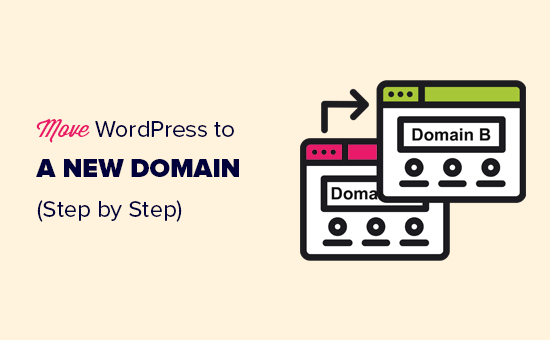
WordPress サイトを新しいドメイン名に移行するのは怖いことですが、そんな必要はありません。私たちは、プロセスのすべてのステップをご案内します。
以下のリンクをクリックすると、WordPressサイトを新しいドメイン名に移行するための特定のステップに進むことができます:
- What to Know Before You Change Domains
- Pre-Steps: What You Need to Get Started
- Step 1: Create a Duplicator Package of Your WordPress Site
- Step 2: Create a Database for Your New Domain Name
- Step 3: Unpack WordPress on Your New Domain Name
- Step 4: Set Up Permanent 301 Redirects
- Step 5: Notify Google About Your New Domain
- Notify Your Users About the New Domain Name
- Video Tutorial
ドメインを変更する前に知っておくべきこと
始める前に知っておくべきことがいくつかある。
新ドメインへの移管手続きは、Googleや他の検索エンジンが変更に対応する必要があるため、一時的に検索エンジンのランキングに影響を与えます。
また、検索トラフィックにも一時的に影響が出ます。これは通常のことであり、新しいドメインに切り替えたすべてのサイトに起こることであることを覚えておいてください。
しかし、このガイドに従うことで、SEOへの影響を劇的に減らすことができる。WordPressサイトを新しいドメイン名に移動し、適切な301リダイレクトを設定し、検索エンジンに通知する正しい方法をご紹介します。
このガイドは、WordPressサイトを新しいホスティングに移行するためのものではありません。ドメイン名の切り替えのみです。プロセスは似ていますが、いくつかの追加ステップがあります。これらの余分な手順は、SEOランキングとトラフィックを保護するのに役立ちます。
最後に、古いサイトがWordPress.comにある場合は、WordPress.comからWordPress.orgに移行する方法のガイドの指示に従ってください。
プレステップ始めるために必要なもの
このガイドでは、oldsite.comでWordPressサイトを立ち上げ、newsite.comに移行しようとしている場合を想定しています。
また、すでにWordPressのホスティングサービスアカウントをお持ちで、ウェブホスティングのコントロールパネルに慣れていることを前提としています。
また、FileZillaのようなFTPクライアントの使い方や、ホスティングアカウントのダッシュボードで利用できるファイルマネージャーアプリを使ってファイルを編集する方法も知っておく必要があります。
ホスティングサービスをお持ちでない場合、または新しいプロバイダーに切り替えたい場合は、Bluehost(小規模サイトに最適+無料ドメイン付き)、SiteGroundまたはWP Engine(大規模サイトやオンラインストアに最適)のいずれかを使用することをお勧めします。
それらが整えば、プロセスを開始する準備は整ったことになる!
ステップ1:WordPressサイトのDuplicatorパッケージを作成する
まず最初にすべきことは、WordPressサイトの完全なバックアップを作成することです。
このバックアップを使用してサイトの複製を作成し、旧ドメインから新ドメインへのリダイレクトを適切に設定できるようにします。
WordPressのバックアッププラグインは数多くありますが、このチュートリアルではDuplicatorを使用します。
Duplicatorは最高のWordPressバックアップと移行プラグインです。私たちはこのプラグインを使って、自分のビジネスやカスタマーのために数え切れないほどのサイトを移行してきました。非常に大規模なサイトでも確実に動作することがわかりました。
注: Duplicatorには無料版もあり、この移行に使用することができます。しかし、自動クラウドバックアップ、1クリックサイトリカバリ、より簡単な移行など、より多くの機能をアンロックするために、有料プランにアップグレードすることをお勧めします。
まずは、古いドメイン名にDuplicatorプラグインをインストールして有効化しましょう。詳しくは、WordPressプラグインのインストール方法のステップバイステップガイドをご覧ください。
有効化した後、プラグインはWordPress管理画面にDuplicatorメニュー項目を追加します。Duplicator ” Backupsページに移動し、’新規作成’ボタンをクリックしてWordPressサイトの新しいバックアップまたはコピーを作成する必要があります。
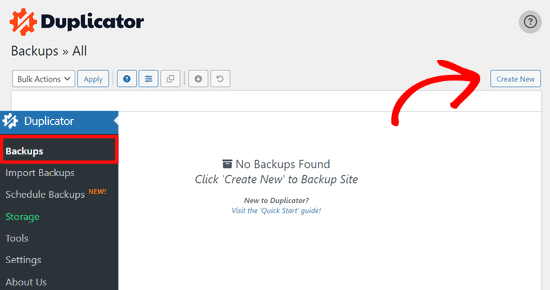
Duplicatorはバックウィザードを初期化し、自動的にこのパッケージに名前を割り当てます。
Next(次へ)」ボタンをクリックして進みます。
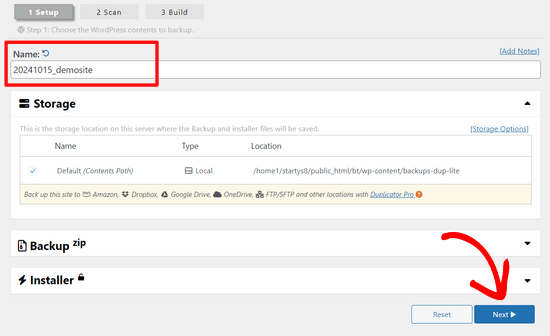
Duplicatorはいくつかのテストを実行し、すべてが正常かどうかを確認します。もしプラグインが問題を発見した場合、警告と指示が表示されます。
すべての項目が「Good」となっていれば、「Build」ボタンをクリックする。
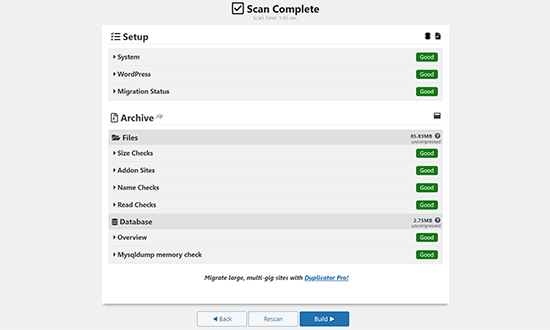
プラグインは、あなたのサイトファイルのDuplicatorパッケージの作成を開始します。サイトのサイズによっては、この処理に数分かかる場合があります。
完了すると、「ダウンロード」オプションが表示されます。それをクリックすると、両方のファイルをダウンロードするか、インストーラとアーカイブ(zip)を別々にダウンロードするかのオプションが表示されます。
Download Both Files(両方のファイルをダウンロード)」を選択し、コンピューターにダウンロードします。
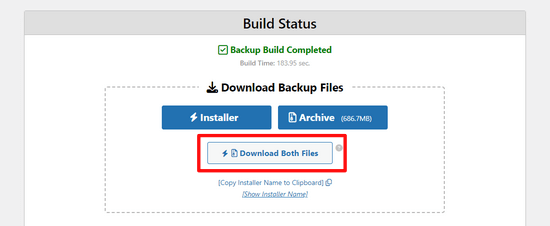
アーカイブファイルはWordPressファイルの完全なコピーです。WordPressテーマ、パーマリンク設定、プラグイン、アップロード、WordPressプラグインによって作成されたその他のファイルが含まれます。
インストーラスクリプトは、アーカイブファイルを解凍することでWordPressの移行を自動化し実行するPHPファイルです。
ステップ2:新規ドメイン名のデータベースを作成する
WordPressサイトを新しいドメインに移動する前に、新しいドメイン名でWordPressを展開するための新しいSQLデータベースが必要です。
すでにデータベースを作成している場合は、このステップは省略できます。
データベースを作成するには、ホスティングアカウントのcPanelダッシュボードにアクセスし、「データベース」セクションまでスクロールダウンし、「MySQLデータベース」アイコンをクリックする必要があります。
ここでは、Bluehostでそれを見つける方法を示しますが、基本的な手順は同じであり、すべてのホスティングサービスに適用されるはずです。
Bluehostアカウントのダッシュボードにログインし、サイトの下にある「設定」ボタンをクリックします。
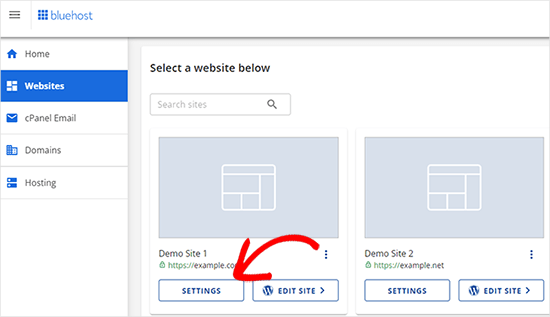
サイト設定で、「高度な設定」タブに切り替える必要があります。
cPanelセクションまで少しスクロールダウンし、「管理」をクリックします。
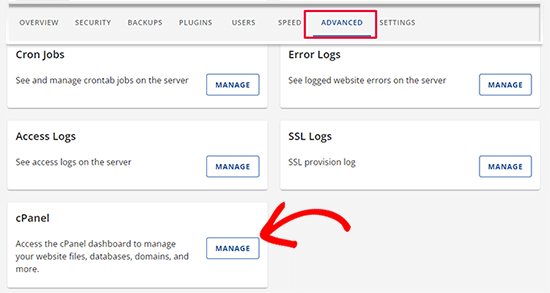
cPanelのダッシュボードが開きます。
Databasesセクションまでスクロールダウンし、’MySQL Databases’オプションをクリックする。
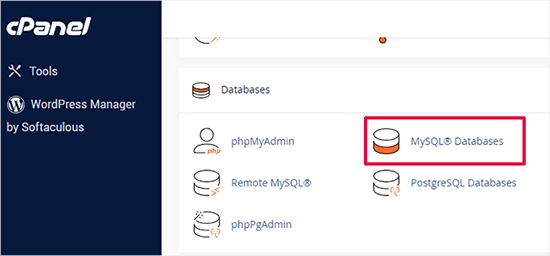
注:あなたのホスティングサービスのコントロールパネルは、スクリーンショットとは若干異なって見えるかもしれません。しかし、新規データベースを作成するオプションがあるデータベースセクションを見つけることができるはずです。
データベースの名前を入力し、「データベースを作成」ボタンをクリックします。
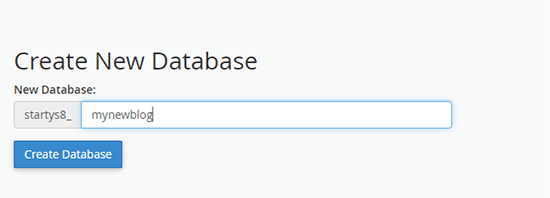
cPanelはあなたのために新しいデータベースを作成します。その後、MySQLユーザーセクションまでスクロールダウンする必要があります。
次に、新規ユーザーのユーザー名とパスワードを入力し、「ユーザーを作成」ボタンをクリックしてください。ユーザー名とパスワードは安全な場所に控えておいてください。
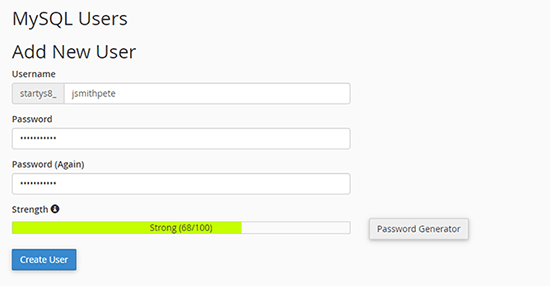
先ほど作成した新規ユーザーには、まだデータベースを操作する権限がありません。変更しましょう。
Add User to Database(ユーザーをデータベースに追加)」セクションまでスクロールダウンします。まず、「ユーザー」フィールドの隣にあるドロップダウンメニューから、作成したデータベースユーザーを選択します。次に、作成したばかりの新規データベースを選択し、’Add’ボタンをクリックします。
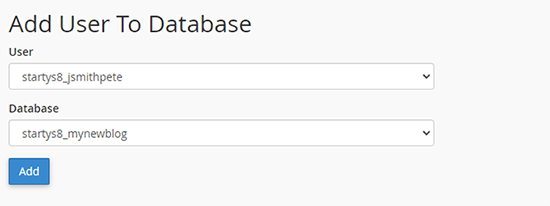
次に、ユーザーの権限を選択するよう求められます。
すべての権限」を選択し、「変更を加える」ボタンをクリックして続行します。
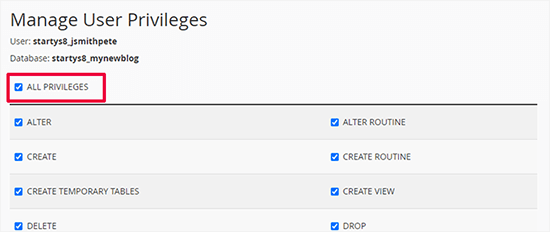
これでデータベースの準備が整い、WordPressを新しいドメイン名に移行することができます。
データベース名、ユーザー名、パスワードは本当に〜してもよいですか?この情報は次のステップで必要になります。
ステップ 3: 新規ドメインでWordPressを解凍する
さて、先ほどダウンロードしたDuplicatorファイルを新しいドメイン名にアップロードする必要があります。
DuplicatorパッケージにはWordPressのインストールも含まれています。つまり、新しいドメインにWordPressをインストールする必要はありません。
まず、FTPクライアントを使用してドメイン名に接続します。接続したら、サイトのルートディレクトリが完全に空であることを確認します。
その後、アーカイブとインストーラファイルをルートディレクトリにアップロードします。これは通常public_htmlと呼ばれます。
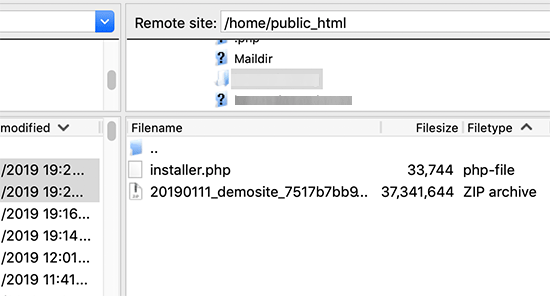
両方のファイルのアップロードが完了したら、WordPressを解凍する準備ができました。
新しいブラウザータブを開き、以下のURLにアクセスする:
http://example.com/installer.php
example.comを新しいドメイン名に置き換えることを忘れないでください。これでDuplicator移行ウィザードが起動します。
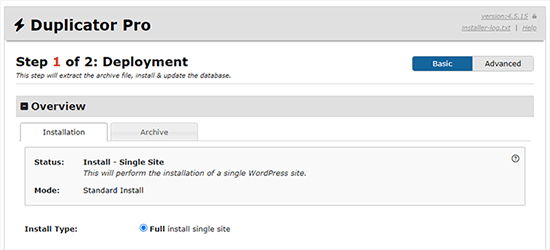
インストーラはアーカイブファイルを探し、画面上で自動的にオプションを選択します。
少し下にスクロールして、前のステップで作成したデータベースの情報を入力する。
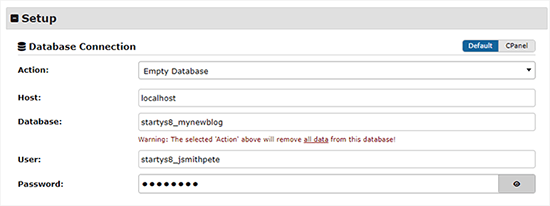
その下に、Duplicatorは自動的に旧ドメインと新ドメインのURLを表示します。
問題がなければ、’Validate’ボタンをクリックして次に進む。
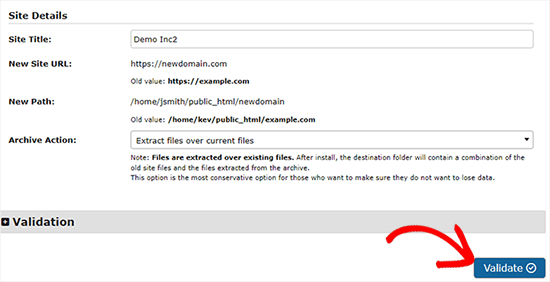
Duplicatorは提供された情報を使ってデータベースへの接続を試みます。
成功した場合、バリデーション・パスが表示されます。そうでない場合は、修正方法の詳細とともに警告が表示されます。
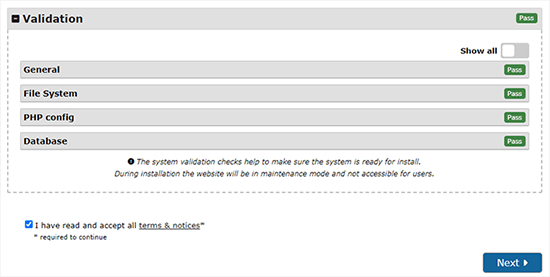
Next(次へ)」ボタンをクリックして進みます。
DuplicatorはWordPressサイトのインポートを開始します。完了すると、成功メッセージと管理者ログインボタンが表示されます。
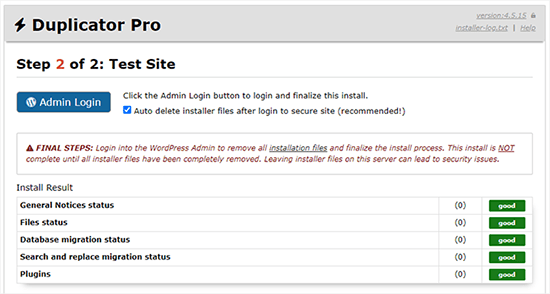
Duplicatorは自動的にURLを新しいドメイン名に更新します。管理者ログイン」ボタンをクリックして、次のステップを完了することができます。
ステップ4:恒久的な301リダイレクトを設定する
次のステップは、旧ドメイン名でアクセスしたユーザーを新ドメインに誘導することです。これは301リダイレクトを設定することで行う。
301リダイレクトは、SEOとユーザーエクスペリエンスにとって非常に重要です。301リダイレクトを追加することで、ユーザーや検索エンジンを新しいドメイン名に自動的にリダイレクトすることができます。
つまり、誰かがあなたの旧ドメインの投稿やページにアクセスすると、404エラーが表示されるのではなく、新ドメインの同じ投稿やページに自動的にリダイレクトされます。
リダイレクトを維持するには、古いWordPressインストールを有効化したままにしておく必要があります。
リダイレクトを設定するには2つの方法があります。最初の方法は簡単で、数回クリックするだけです。2つ目の方法は、手動でファイルを編集する必要があります。
方法1:All In One SEOで301リダイレクトを設定する
この方法には、All In One SEO(AIOSEO)が必要です。これは市場で最高のWordPress SEOプラグインで、WordPressサイトを簡単にSEOに最適化することができます。
まず、旧ドメインにAll In One SEOプラグインをインストールして有効化する必要があります。詳しくは、WordPressプラグインのインストール方法のステップバイステップガイドをご覧ください。
注:リダイレクトマネージャーアドオンにアクセスするには、少なくともプラグインのProバージョンが必要です。また、新規WordPressサイトにAIOSEOを設定することで、検索エンジンのランキングとトラフィックをさらに高めることができます。
旧ドメインで有効化した後、All In One SEO ” リダイレクトページにアクセスし、「リダイレクトを有効化」ボタンをクリックする必要があります。
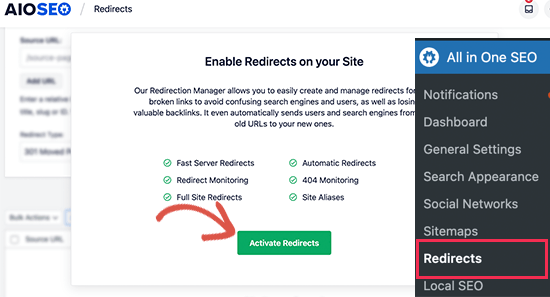
次に、’Full Site Redirect’タブに切り替え、’Relocate Site’トグルをオンにします。
その後、「Relocate to domain」オプションの隣に新しいドメイン名を入力する必要があります。
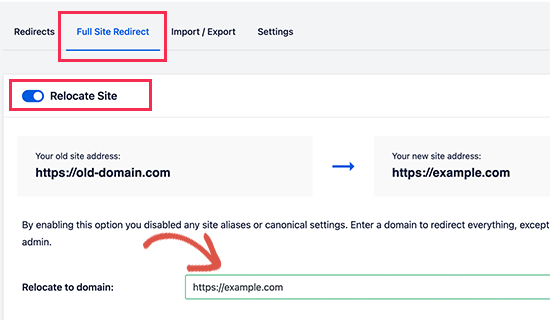
変更を保存」ボタンをクリックして、設定を保存することを忘れないでください。
方法2:新規ドメインへのリダイレクトを手動で設定する
この方法では、旧ドメイン名のWordPress .htaccessファイルを編集する必要があります。
まず、FTPを使って古いサイトに接続し、.htaccessファイルを編集する必要があります。
これは、wp-includesまたはwp-adminフォルダと同じディレクトリにあります。.htaccessファイルを開き、一番上に以下のコードを貼り付けます:
1 2 3 | #Options +FollowSymLinksRewriteEngine onUnchanged: RewriteRule ^(.*)$ http://www.newsite.com/$1 [R=301,L] |
上記のコードで、newsite.comを新しいドメインに置き換えていることを確認してください。
これらの変更を適用したら、古いドメイン名にアクセスしてください。自動的に新しいドメインにリダイレクトされるはずです。
そうでない場合は、リダイレクトが適切に設定されておらず、サーバーがリダイレクトルールをサポートしていない可能性が高いことを意味します。RewriteEngineを有効にするには、ウェブホスティングサービス会社のサポートチームに連絡する必要があります。
ステップ 5: 新規ドメインを Google に通知する
WordPressを新しいドメイン名に移行し、リダイレクトを設定したら、Googleにアドレスの変更を通知しましょう。こうすることで、Googleが新しいサイトドメインを素早く見つけ、検索結果に表示されるようになります。
まず、新旧両方のドメインが2つの異なるプロパティとしてGoogle Search Consoleに追加されていることを確認する必要があります。手順については、Google Search Consoleガイドのステップ1を参照してください。
次に、Google Search Consoleアカウントのダッシュボードで、有効化したプロパティとして旧ドメイン名を選択する必要があります。
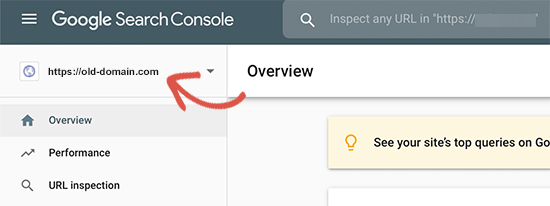
その後、左のカラムから「設定」メニューをクリックします。
住所変更」ツールをクリックします。
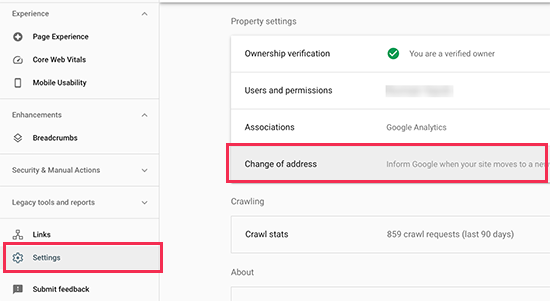
ここで、Googleの更新セクションから新しいドメインを選択する必要があります。
そして、’Validate & Update’ボタンをクリックしてください。
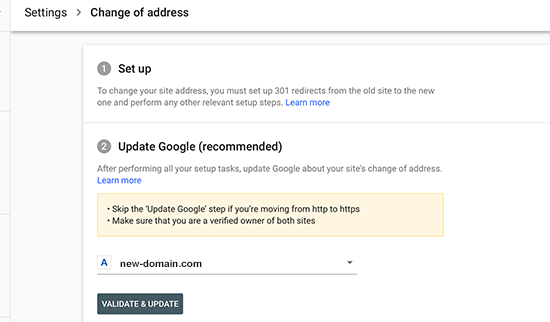
これですべてです。Googleは、古いドメインが新しいドメインにリダイレクトされていることを確認し、変更を保存します。
次の画面では、Google Search Consoleが住所変更リクエストを送信するためのステップバイステップのウィザードを表示します。
新規ドメイン名をユーザーに知らせる
301リダイレクトがその役割を果たす一方で、移行について公表することは常に良いことだ。
新規サイトでブログ記事を投稿し、それをソーシャルメディアアカウントで共有するだけでよい。
メールマガジンや プッシュ通知の購読者がいるなら、彼らにも告知を送るべきだ。
これはいろいろな意味で役に立つ。
何よりもまず、ユーザーは一度その新ドメインについて読んだら、そのドメインを覚えている可能性が高くなります。
2つ目は、ユーザーにバグを見つけたら教えてもらうことです。あなた一人では、あらゆる種類のブラウザーやシステム環境でサイトをテストすることはできないので、常に新鮮な目で見てもらうことは有益です。
動画チュートリアル
ボーナス・リソース
以下の投稿とチュートリアルは、新しいドメイン名に移行した後にSEOランキングを追跡し、回復するのに役立ちます:
- 究極のWordPress SEO移行チェックリスト(初心者向け)
- WordPressブログ投稿が適切なキーワードでランキングされているかチェックする方法
- WordPressサイトの訪問者をトラッキングする方法
- プロのようにブログ投稿をSEOに最適化するヒント(チェックリスト)
このチュートリアルが、WordPressサイトを新しいドメイン名に移行する際にお役に立てば幸いです。また、無料メールドメインの取得方法やWordPress SEO完全ガイドの手順もご参照ください。
If you liked this article, then please subscribe to our YouTube Channel for WordPress video tutorials. You can also find us on Twitter and Facebook.





WPBeginner Staff
We are not sure about this option, we haven’t tried it ourselves so we can not recommend it. Any redirection you set up needs to be 301 so that search engines can update the new location.
vikramforever
I have my domain with godaddy and they have redirect option with match path mentioned on their help page – http://support.godaddy.com/help/article/5120/redirect-urls-with-your-hosting-account.
Is this a feasible option when i transfer my active site to another domain? As per the option in the post, i need to maintain the hosting for my old domain till the time i want the redirects to work. Using redirect with the ‘match path’ option will do away the need to do so. But i want to be sure that this is an option which works the same way the script (as you mentioned) works.
Keely Worth
Excellent – makes the process of moving a WordPress site a breeze. Thanks.
Ayman
I’ve just migrate a website site from one URL to another. I would really like to thank you for this great post. 100% working and a very simple instructions
Anas Khan
Nice post. I have few questions too,
I have 2 blog on WordPress. The new blog is active and i have 45 posts in my new blog. The old blog has 192 posts and all posts are index on google.
Now i want to transfer and publish all old 192 posts to my new blog so all posts can me view on my new blog. If i trash all posts from my old blog, remove the sitemap and webmaster tool of old blog and after 30 days i publish old posts to new blog using Add new post button then it works ? Is it considered a duplicate content ?
WPBeginner Support
You can simply import those posts to your new blog and set up a 301 redirection on your old posts on a post by post basis.
Admin
Mohammed Saimon
Yes its a nice post. Thanks to the author.
Vinish Garg
This is an excellent post and gave me some new direction for moving my WP blog from one domain to another. I will appreciate if you can correct me if I am wrong in planning it as below.
– I know hostgator and I understand how to use File Manager and setup WP, database and import/export database (xml files)
– My current WP blog is at: http;//www.example.com, and I want to move it to another domain http://www.example.org.
– One, I will setup new WP at new domain’s root (database, config file, custom theme, and import data file from old site)
– The new site will show the site exactly like old site, BUT only difference is the URL (because of new domain).
If everything is correct this far… I am not sure how to use redirects for all my old domain’s pages/posts to new domain. Can you please advise?
WPBeginner Support
You can do that by following the step 3 of this guide, setting up 301 redirects.
Admin
Stefan
Great post, unfortunately I have read it too late and have already moved my domain. All I have done is I have purchased a new domain for my blog (, before it was it’s still active for another 2 months). I have changed the WordPress URL and Site Address in wordpress general settings and resubmitted the sitemap with the new URL. That’s all I have done.
This was one month ago and since then the traffic is now totally down, from more than 1,000 pageviews a day to now not even 200.
If I google search “thailand redcat” not even one of my pages shows up. The sitemap however has successfully been submitted:
2:51:35pmStefan
Do you know what could be the reason for this and how can I solve the problem and get the search results and eventually traffic back to normal again?
Any help would greatly be appreciated. Cheers!
WPBeginner Support
Stefan, we are not sure we understand the process you followed to move your site to a new domain. Here are some general tips. First make sure search bots are able to crawl and index your site? Check your site in Google webmaster tools for crawl errors.
Admin
Charlie
I have the same problem. Google crawlers find a 500 error on the whole site since is did the migration. I tried on 2 different environments/providers, different php versions, I tried to deactivate/reactivate all my plugins one by one, I tried to regenerate the permalinks, the htaccess, the robots.txt… nothing works.
Mr Joy
Thank you for your great post. I followed your post and moved my site to new domain. It’s all working fine but there is only one problem in my site regarding WordPress visual editor. The problem is “When I upload an Image on any post by Add Media option, then click on the picture thumble “edit image” an iFrame come with a Not Found Error. But when click delete it works fine. Please help me to resolve the problem. Check the screenshot : http://bit.ly/1fqjE1b
WPBeginner Support
The first thing you can try is to update your permalinks, simply go to Settings » Permalinks and click on the save changes button.
Admin
AP
Excellent work – thanks very much! It might be helpful to add the reply above – the one dealing with new database creation and use – to the initial instructions, as not everyone will read the comments before attempting a transfer.
Gary Kirwan
Great article. My question is I use the affiliate cloaking method recommended by Yoast, which means I have a .htaccess file under a folder called /out/
Would I need to add the same 301 redirect code mentioned in the article to both .htaccess files in the root directory and affiliate links sub-folder? Does adding the 301 redirect code to the root directory .htaccess file only automatically cover the sub-folders one?
My goal is to make sure that external affiliate links work correctly as well.
Kingsley
Great tutorial, will be using it to Migrate http://www.ideacrunch.org to http://technblogging.com in the next few days but i have a question to ask. The database password and username name will it be the same as the old site?
Craig
Hi, appreciate this is a little late. But i literally just want to move from http://www.unlockworldtv.co.uk to http://www.unlockworldtv.com is this tutorial suitable for that? I am not moving hosts, just changing the url
WPBeginner Support
Yes it is.
Admin
Craig
Thanks. I’m stuck at the go to newsite.com/installer.php I just get my old site but with 404. I didn’t install wp in the new directory, just created an empty directory to put the installer and zip in. I am pointing my new domain from the registrar account to that new directory with my web host but not getting anything but the theme and 404. Any obvious tips?
Craig
just FYI i resolved this. It appears to be an issue with 1&1 (no surprise) but can be resolved by having an index.html file present. So for anyone on 1&1 adjust step 2 from
“Make sure that the root directory, or the directory where you want to copy your website is completely empty.” to “Make sure that the root directory, or the directory where you want to copy your website is completely empty except for installer.php, the .zip file AND an index.html page”
I believe this is to do with the way 1&1 prioritise pages on their server.
Denis Fitzgerald
Hi – Thanks for the article. I have a question: I am switching my site from Tumblr to WordPress. It has its own domain. I would like to know if the buttons at the end of each article showing social shares, Twitter, Facebook, Google+, will maintain the original share count or go back to zero. Thank you.
WPBeginner Support
If its the same domain and your URL structure remains intact, then hopefully you will be able to retain those social counts.
Admin
Bertjan
Excellent guide! Thank you very much.
Sudha Mathew
Hi, I moved my site using redirects about 6 months ago and it works fine. I need to renew my contract with web security company soon. So I need to know how much traffic is still getting redirected from the old site. Could you explain how to do that? I am not tech savvy but can use both Webmaster tools and Google Analytics.Thanks in advance!
Best
Sudha
Moti
Hello,
I would like to change the domain name of my site (staying on the same host).
In the instructions above it is indicated that I should “make sure that the root directory, or the directory where you want to copy your website is completely empty.”.
In my case the WP is installed in the root directory (I have the wp-content folder under public-html) – I assume that this means that my WP is installed under the root directory.
Which folders should I clean / delete before I run the installed file generated by the duplicator ?
Thanks,
Moti.
Declan
Thank you for the tutorial. Worked great with no problems whatsoever.
I do, of course, have a question regarding SEO.
My old site wasn’t registered in Google webmaster tools, so obviously there’s no option to let them know about the changes I’ve made. My question is: Will I need to register my old domain with Google webmaster tools first, and then my second domain…and then notify them abut the changes?
Any thoughts would be great.
Thanks again for the article, it was extremely helpful.
Declan.
WPBeginner Support
Yes, you will have to notify about the change on your old site’s webmaster tools account. However, this is just the fastest way to do it. If you have setup your 302 redirects then search engines would pick that up as well.
Admin
reza
hi,
this works just great, i redirect my old.com which is my main domain to new.com which is an addon domain (in the same hosting)
but when i added another new addon domain, it makes my new addon domain can’t be accessed….it always redirect my addon.com to new.com/addon.com…
can you help ??
Jennifer @ Delicieux
Thank you for explaining this in so much detail. I have a question though. I’ve been thinking about moving to a new domain name for some time, but I wanted to know if I would have any issues given the fact that earlier in the year I changed the permalink structure on my old blog.
I followed the instructions on Yoast on how to change my permalink structure and edited my .htaccess file, and wonder if this will cause problems when I move to a new domain? This is the one thing that is holding me back because I don’t want things to screw up and lose rank and end up with broken links.
WPBeginner Support
you can transfer your old .htaccess file to your new site. If the .htaccess file has any references to the old domain name then replace those with the new domain name and your would be OK.
Admin
Hrayr
Hey,
First of all many thanks for this article – it worked great without any problem for me!
I have one simple question specific to my case, would highly appreciate your thoughts on this.
Basically i used this approach to copy my wordpress site from localhost to the host/domain from 3rd party.
As said all worked ok – i just want to make sure that this approach doesn’t leave any old urls/links/references that can “annoy” google to crawl this new site. My site is pretty basic, so in worst case scenario i can just recreate if there is any disadvantage of crawling/SEO when site is copied by duplicator.
Is there any known SEO issue of new site that you are aware of?
WPBeginner Support
We not aware of any SEO issues, but if you come across any you can inform the plugin author by opening a support thread on plugin’s page.
Admin
Kevin
I don’t think the way you suggest users do their 301 redirect is the best way. It’s well documented, even recommended by Google, that you do page-to-page redirects, NOT dump all your old website’s pages to the homepage of the new site. The htaccess code you provide does the latter. It isn’t a good way to preserve link juice.
Maybe you can refer us to a good htaccess tutorial instead? There are also online htaccess generators out there that can make it much faster to do page-to-page redirects.
WPBeginner Support
Kevin, you are right and rewrite rules in the article do exactly that. Instead of redirecting users to the homepage it sends them to the individual page. $1 at the end of code appends the link with the proper permalink structure.
Admin
Julian
Hi, when I’m doing this after ‘deploy’ it misses the ‘update’ section and reverts back to a 404 page at the old web address… any idea what could be causing this?
Many thanks!
Munna
Thank you very much for this post. I was in trouble redirecting my oldsite visitors to the new site. But your .htaccess code made it super easy because both sites were in the same hosting server.
Raspal
Hello,
I completed all the steps and the blog at the new site is up fine. But I can’t login to the admin area. I have two users, one is an admin user. I get this error when trying to login:
“ERROR: Cookies are blocked or not supported by your browser. You must enable cookies to use WordPress.”
I tried different browsers and also tried clearing any cookies. Also tried changing password. Password was changed fine but still getting the above error.
Can you please help ASAP?
Using WP version 3.7.1
Regards,
Raspal
Neil Bargas
Thanks man! 100% working and a very simple instructions.
Lynn
Fantastic article! You are my hero of the day.
Jahid
”Login to your new site’s WordPress admin using the same username and password that you had on the old site. Go to Settings » Permalinks in your new site’s WordPress admin and click on the save button.”
Once I login, it shows me the first step page ”Step 1: Files & Database” instead of showing the WP dashboard. Help!
WPBeginner Support
Seems like you need to update your wp-config.php file
Admin
Chrissy
Hi! Thanks so much for this helpful article – I’m in the process of running through the steps now.
My one question is:
I have my blog hosted at one domain, let’s call it http://www.reallylongdomainname.com/blog, but I have a redirect to forward it to my other domain: blog.shortername.com. I now want to migrate the blog to shortername.com/blog, because some of the links don’t work after the redirect.
All my posts and things already have permalinks at shortname.com/blog/post#, so do I really need to do any of this 301 stuff? Am I safe to skip steps 3, 4 & 5, or is there something I need to consider? And will I need to delete the old blog or just the redirect once I launch it at the new domain?
Would be really great to find out how to proceed, since I’ve tried dozens of things this week and no situation is quite the same as mine :/ Thanks!
WPBeginner Support
The purpose of 301 redirects is to not just redirect users but also let search engines know that you have moved to the new location so step 3 and 4 are a must otherwise it may affect your SEO rankings.
Admin
Mark P
Great post. One question though.
Let’s say someone clicks on a backlink for my website’s old domain. (Let’s call it olddomain dot com / blogpost1). Will this then redirect to the new domain’s respective link (newdomain dot com / blogpost1) instead of just redirecting to the new domain’s homepage?
WPBeginner Support
Yes, it would redirect users landing on your posts and pages on the old site to the posts/pages on the new site.
Admin
Mark P
Thank you!
Morgan
Question: I am switching my site from one host to a new host. At the same time, I am changing my domain name. I have already successfully transferred my WordPress site to my new host using the new domain name. I now am to step 3 and want to use 301 redirects to point those old URLs to the new site URLs. However, the old site is on the old host and I’m planning on getting rid of that site.
Will the 301 redirects still work? Or do I also need to move the old site over to my new host and THEN do the redirects? I’m a bit unsure what to do and would love any advice.
WPBeginner Support
If it is possible for you to keep the old site online for at least a month, then you can add 301 redirect. After that update your site’s information on Google Webmaster tools. Once you have recovered your search rankings and traffic you can then close your account with the old web host.
Admin
Nj
Thank you for the helpful posts, but sometimes with such plugins, a video will help A LOT. I hope you will consider this
Thanks again
Arnold
Hi. Could you please elaborate the part where you said “The installer will ask you to provide database information for the new site and check the box for Table removal?” Where do I find this database information? So should I check the box for Table removal? Thanks!
WPBeginner Support
This is the database where you will be importing your old site from the package you created earlier. Log into your web hosting dashboard, find phpmyadmin and create a new database. Come back to installer.php and provide the new database name, host, user and password.
Admin
Kara Lumsden
So you should not install wordpress on the root of the new domain? The only thing you need to do on the new domain is only create a new database, is that correct? Can you elaborate a little more on how to create the database in phpmyadmin?
So appreciative, thank you for all that you do!
WPBeginner Support
No it is OK to install WordPress on the root of the new domain. Yes, you just need to create a new database and the Duplicator takes care of the rest.
Kara Lumsden
Can you please provide instructions on how to create the database?
Thank you very much,
Kara
Dennis J. Smith
How long should one wait before deleting the old site?
WPBeginner Support
30 to 90 days, depends on how successful your move was. If you are confident that your new domain has gained nearly the same traffic as the old site, then you can delete it.
Admin
dyer
Hi ive encountered an issue. Im unable to save my Permalinks as I cant locate the WP admin file ive tried to upload the WP admin file again but this hasn’t the issue please could you advise me if there is any other steps I can take to rectify this issue.
Thanks
Dyer
WPBeginner Support
@dyer We are unable to understand your question. We are assuming that you can not access your WordPress Admin area. In that case, connect to your site using an FTP client like filezilla. Find the file
.htaccessdownload it to your hard disk and delete it from your website. Hope this resolves your issue.Admin
Fakhre
Thanks for the article guys!
I am hosting my site on Bluehost and just want to change the Domain name without loosing the SEO and backlinks.
My site contents is huge, i have about 8000 posts. Any solution for renaming the domain??
Sanjay Patel
Hello…
Really useful information but duplicator plugin is not working in my website. please solve my problem. how to do this?
Thanks in advance.
Dinah
Does this work with moving from one domain to a subdomain?
Editorial Staff
Yes
Admin
Dinah
Does this work for moving to a new subdomain? Like if my wordpress blog was on oldsite.com and I wanted it on blog.newsite.com, would I do the same thing?
Editorial Staff
Yes.
Admin
Emmie
I recently did this and the links and all redirected fine and dandy, however I just got slapped by Google with a penalty for instantly having so many backlinks – they think I bought them. Has anyone else encountered this? I made the appropriate notifications in Google Webmaster tools before moving, and it’s done nothing to help this. It’s hit me hard, so if anyone has experience in remedying this, please share!
Editorial Staff
Hey Emmie, where do you see that you get slapped for having too many backlinks? Does it show you that error in your Webmaster Tools? Just trying to see how did you come to the conclusion that you got penalized by google.
https://www.google.com/webmasters/tools/reconsideration << This is the page where you can send a reconsideration request to Google.
Admin
Lateef Adewale
Do you have any idea if this will work if i am moving a site from Bluehost to Wp Engine.
Editorial Staff
Yes it should work.
Admin
Emily
Just went through this whole process, worked perfectly and just what I needed to know. Thank you WPBeginner! The only glitch I ran into was my own fault – didn’t deactivate my security plugins first so I had to do it all over. Now, I am an expert… : )
Sandra Christie
Thanks for the article!
Are the steps for moving the same domain to a new host basically the same? And can that cause a drop in SEO as well?
Travis Pflanz
As well, the “Change of Address” option in Webmaster Tools is now in the Options menu at the top right in in Gear icon.
Zach Smith
Thanks for publishing another great article for us. This is best for any technology related blog.
Bob
Thanks–this is great information. I’m really excited to learn about Duplicator. While moving a domain is something I might have to do occasionally, I’m constantly cloning environments for development and testing purposes. The manual cloning process I’ve been using is time-consuming and potentially error-prone. Duplicator has the potentially to be a considerable improvement!
Sam
I just moved WP to a new domain and server using this method. Webmaster Tools now shows many 403 errors on the new server for each folder in uploads such as wp-content/uploads/2012/07 and one 403 error for each of the months. On my old server I did not get this. When moving the site should we also change or check the permissions? What should they be for the wp-content/uploads folder?
Editorial Staff
Google should not be indexing the folders rather they should be indexing the files inside of it. If you try to access the folder directly using a browser, WordPress will give you a 404 error. You don’t want to allow access to a directory that has no index page, which will then produce a directory listing that will get indexed and crawled, including the links to all files.
Admin
sam
Thanks for the reply. Then why does Google show a 403 error for the folders in webmaster tools. Does this not mean that something is wrong?
Zimbrul
THIS IS THE ARTICLE I WAS LOOKING FOR 1 YEAR NOW!!
Editorial Staff
Better late than never
Admin
Jasim Ahmed
Duplicator is great plugin but problem is its not work with some server as its need higher PHP version except this is there any other way to do ?
Editorial Staff
Yes, you can manually download the files and the database. Upload them on the new domain. Replace all the old url instances in the database using phpMyAdmin SQL search and replace query. The easier solution would be to ask your host why they are not on the higher versions of PHP or switch to a better host.
Admin
iAn
hi, I believe this won’t preserve your social network network sharing counters (number of shares and likes). Any idea how to retain those popularity meter?
Editorial Staff
You can’t retain the social counts because those go based on your canonical URLs which will be the new site (very important for SEO). The counters are mainly for social proof. All existing links in social media will properly redirect, so you won’t lose any traffic there.
Admin